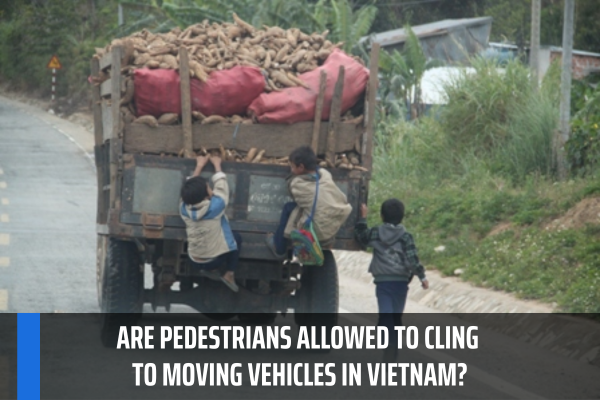Are pedestrians allowed to cling to moving vehicles in Vietnam? If not, what are the penalties?
- Are pedestrians allowed to cling to moving vehicles in Vietnam?
- What are the penalties imposed upon pedestrians clinging to moving vehicles in Vietnam?
- Does the Chairman of the Commune People's Committee have the authority to impose administrative penalties for pedestrians who cling to moving vehicles in Vietnam?
- How long is the statute of limitations for administrative violations for pedestrians who cling to moving vehicles in Vietnam?
Are pedestrians allowed to cling to moving vehicles in Vietnam?
Pursuant to the provisions of Clause 4, Article 32 of the Law on Road Traffic 2008, the pedestrians are as follows:
Pedestrians
1. Pedestrians shall use pavements or verges; where pavements and verges are not available, they shall walk close to the edge of a road.
2. Pedestrians may cross a road at places where there are light signals, road markings or flyovers or tunnels reserved for pedestrians, and shall comply with the instructions given by such lights.
3. At places where light signals, road markings, flyovers or tunnels reserved for pedestrians are not available, pedestrians, before crossing a road, shall watch approaching vehicles, may cross the road when it is safe and shall take responsibility to ensure safe crossing.
4. Pedestrians may not walk over the median strip and cling to moving vehicles; if carrying bulky objects, they shall ensure safety and no obstruction to road users and vehicles in traffic.
5. Children under 7 years, when crossing an urban street or a road with regular vehicular traffic, must be led by adults; everyone has the duty to help children under 7 years cross roads.
Thus, based on the above regulations, pedestrians are not allowed to cling to moving vehicles.

Are pedestrians allowed to cling to moving vehicles in Vietnam? If not, what are the penalties? (Image from the internet)
What are the penalties imposed upon pedestrians clinging to moving vehicles in Vietnam?
Pursuant to the provisions at Point d, Clause 1, Article 9 of Decree 100/2019/ND-CP, as follows:
Penalties imposed upon pedestrians violating traffic rules
1. A fine ranging from VND 60,000 to VND 100,000 shall be imposed upon a pedestrian who commits any of the following violations:
a) Failure to stay on designated section of the road; crossing the median strip; crossing the street unsafely or at inappropriate positions;
b) Failure to comply with traffic light, traffic signs and road markings, except for violations specified in Clause 2 of this Article;
c) Failure to obey the orders or instructions of the traffic conductor or traffic guard;
d) Carrying bulky objects in a manner that obstructs the traffic;
dd) Hanging from a moving vehicle.
2. A fine ranging from VND 100,000 to VND 200,000 shall be imposed upon a pedestrian that walks on a freeway, except for the persons in charge of management and maintenance of the freeway.
Accordingly, pedestrians who perform the act of clinging to running traffic vehicles will be fined from 60,000 VND to 100,000 VND.
Does the Chairman of the Commune People's Committee have the authority to impose administrative penalties for pedestrians who cling to moving vehicles in Vietnam?
Pursuant to the provisions of Clause 1, Article 75 of Decree 100/2019/ND-CP as amended by Clause 27, Article 2 of Decree 123/2021/ND-CP, as follows:
Power to impose administrative penalties of People’s Committees at all levels
1. Chairmen/Chairwomen of communal People’s Committees have the power to:
a) Issue warnings;
b) Impose a fine of up to VND 5,000,000 for road traffic offences and rail transport offences;
c) Confiscate any exhibit or instrumentality involved in commission of administrative offences, the value of which does not exceed VND 10,000,000.
d) Enforce the remedial measures specified in points a, b and c clause 1 Article 4 of this Decree.
..
Accordingly, the Chairman of the Commune People's Committee has the authority to impose a fine of up to VND 5,000,000 for violations in the field of road traffic. The maximum penalty for pedestrians who swing or cling to moving vehicles is 100,000 VND.
Therefore, the Chairman of the Commune People's Committee has the authority to impose administrative penalties for pedestrians who swing or cling to running traffic.
How long is the statute of limitations for administrative violations for pedestrians who cling to moving vehicles in Vietnam?
Pursuant to the provisions of Point a, Clause 1, Article 6 of the Law on Handling of Administrative Violations 2012, as amended by Point a, Clause 4, Article 1 of the Law on amendments and supplements to certain Articles of the Law on Handling of Administrative Violations 2020, the statute of limitations for handling violations administrative as follows:
Statute of limitations for handling of administrative violations
1. The statute of limitations for administrative violation sanction is regulated as follows:
a) The limitation period for imposition of an administrative penalty shall be 01 year, except in the following cases:
The limitation period for imposition of sanctions against administrative violations arising from the following sectors and activities: accounting; invoices; fees and charges; insurance business; price management; securities; intellectual property; construction; fishery; forestry; investigation, planning, exploration, extraction and use of water resources; oil and gas and other mining activities; environmental protection; atomic energy; management and development of houses and offices; land; levees; press; publishing; commodity production, export, import and trading; manufacturing and trading of banned and counterfeit goods; foreign worker management, the statute of limitations for sanctioning administrative violations, shall be 02 years.
The limitation period for imposition of sanctions against administrative violations arising from taxes shall be subject to laws on tax administration;
According to the above regulations, the statute of limitations for sanctioning administrative violations for pedestrians who swing or cling to traffic vehicles is 01 year.
LawNet